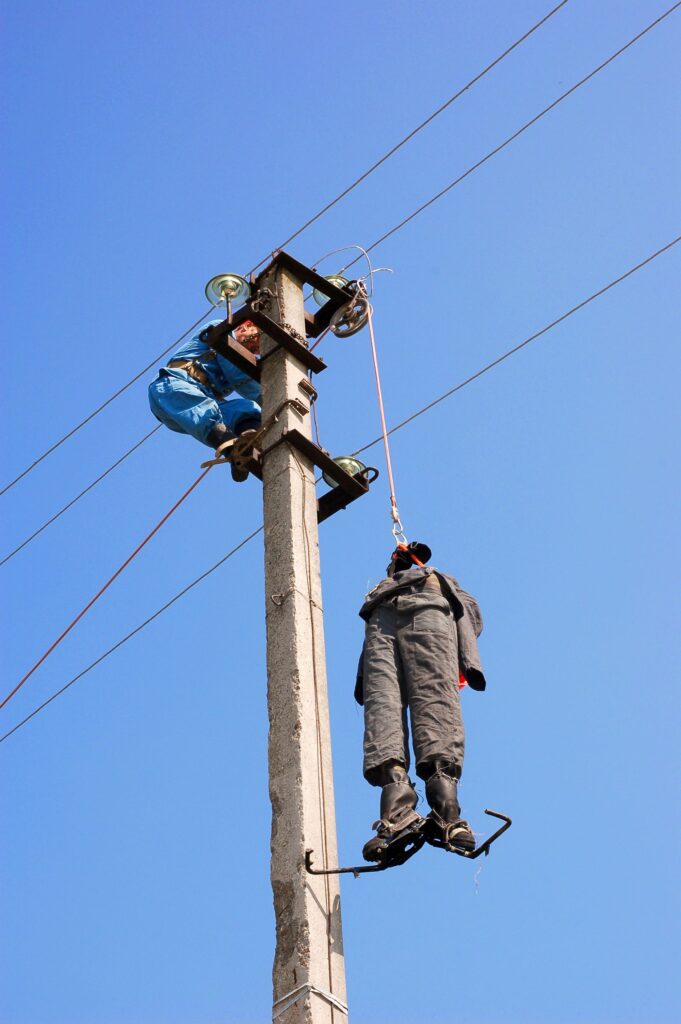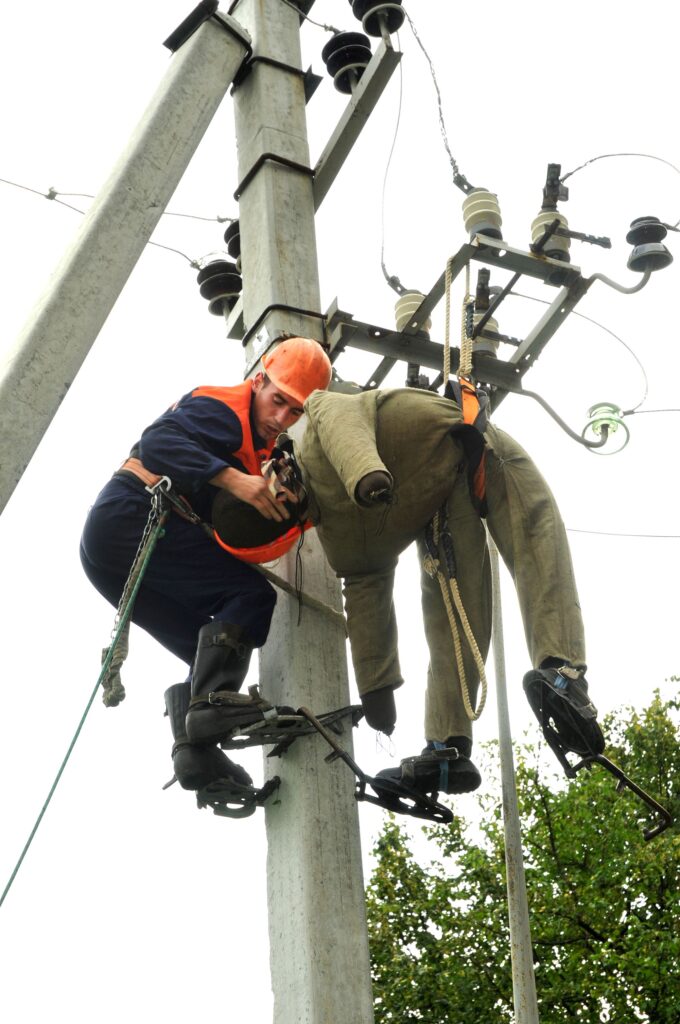Every year, approximately 30 to 50 linemen lose their lives while working. This is a relatively high fatality rate within the utility sector.
The role of an electrical lineman is critical to keeping power systems operational, yet it’s one of the most hazardous jobs in America. The dangers of working with high voltage, often in adverse weather conditions and at great heights, contribute to the notable risks these workers face daily.
Safety is a prime concern, with employers and industry regulators continuously seeking ways to safeguard these vital professionals. For anyone considering a career as a lineman, understanding the hazards and the importance of safety protocols is paramount. This crucial occupation not only demands skill and focus but also a significant commitment to best safety practices to ensure that these statistics can be lowered further in the years to come.
Statistics On Linemen Fatalities
Linemen work high above the ground, fixing electrical lines. They face danger every day. Knowing how often accidents happen is crucial. This section shares important details about linemen fatalities.
Overview Of Fatalities
Being a lineman is one of the most dangerous jobs in the United States. Linemen often climb high on poles. They deal with strong electrical currents. Mistakes can lead to severe injuries or even death. Each year, families lose loved ones who work as linemen. Reports show different numbers for yearly deaths. It’s hard to tell how many die each year.
Trends In Recent Years
Let’s look at the trends over the past few years. We notice changes in the numbers. Some years have more deaths than others. New safety equipment and training help. But risks still exist. Experts keep track of these trends. They want to make this job safer.
The Electrical Safety Foundation International (ESFI) offers reports. They talk about electrical injuries and deaths. The ESFI and other groups share data. Their goal is to prevent accidents.
- Improved safety gear helps reduce risks
- Training programs teach safety practices
- Despite this, deaths still happen some years
Studies point to factors like weather and working conditions. These affect how many linemen die each year. Organizations continue to work hard to make the job safer.
| Year | Deaths | Notes |
|---|---|---|
| 2021 | 29 | Safety improvements noted |
| 2020 | 21 | Impact of COVID-19 |
| 2019 | 31 | Increased awareness |
Education and awareness are key. Each death is one too many. The goal is to bring these numbers down to zero.
Factors Contributing To Linemen Fatalities
The work of an electrical lineman is not only tough but also hazardous. Each year, tragic stories of lineman fatalities make headlines, underlining the dangers these skilled workers face.
Understanding these factors can help us improve safety measures. It can also reduce tragic accidents.
Electrocution Risks
Working with high-voltage lines is at the heart of a lineman’s job. This brings electrocution risks.
- Equipment failure
- Lack of proper safety gear
- Inadequate safety training
Proper protocols are essential. They help prevent contact with live wires. Staying vigilant is key.
Falls And Accidents
Linemen often work at dangerous heights. Falling from poles or towers is a significant risk.
- Slips and trips
- Poor weather conditions
- Faulty climbing gear
Regular safety checkups for gear are vital. They ensure every climb is safe.
Safety Measures For Linemen
The work of linemen is vital but comes with high risks. Every year, line workers face potential dangers that can lead to tragic outcomes. To reduce these risks, implementing robust safety measures is crucial. Protecting linemen is not just a responsibility but a necessity to prevent fatalities and serious injuries within this brave workforce.
Training Programs
Proper training is the backbone of linemen safety. It ensures that workers are well-prepared for the challenges they face on the job. Key aspects of training programs include:
- Understanding electrical systems
- Learning safe work practices
- Mastering emergency response
- Developing problem-solving skills
Training is not a one-time process. Linemen must receive ongoing education to stay updated on the latest safety protocols and equipment.
Use Of Personal Protective Equipment
The use of Personal Protective Equipment (PPE) is a critical layer of protection for linemen. PPE includes:
| Equipment | Purpose |
|---|---|
| Helmets | Protect the head from impacts |
| Gloves | Insulate against electrical hazards |
| Boots | Provide stability and slip resistance |
| Eye Protection | Shield eyes from debris |
| Flame-resistant Clothing | Minimize burn risks |
Every piece of equipment must undergo regular inspections and maintenance to ensure its reliability in protecting linemen from the myriad of hazards encountered daily.
Impact On Families And Communities
The loss of linemen each year leaves a profound mark on both families and communities. Linemen play a critical role in keeping lights on and power flowing. Their risky job sometimes leads to life-altering consequences.
Emotional Toll
The unexpected death of a lineman creates an emotional shockwave. Those closest to them face intense grief and heartbreak. Children lose a guide, partners lose their support, and colleagues lose a trusted team member. These emotional wounds take time to heal and can reshape a family’s dynamics forever.
Financial Consequences
Losing a lineman often means losing the primary earner. The financial burden on families can be immense. While workers’ compensation may provide some relief, it rarely covers all expenses. Families face challenges, from daily needs to long-term goals like education and retirement. In low-income households, the impact can be severe.
Support Systems
- Social security benefits: This may relieve immediate financial stress.
- Community funds: Local donations can provide short-term aid.
Communities also feel the void as linemen are often active volunteers and leaders. Their absence is felt in schools, churches, and neighborhood projects.
| Area | Effect |
|---|---|
| Family | Grief, Loss of Income |
| Community | Loss of Leadership, Volunteerism |
Healing and Recovery
- Counseling and support groups.
- Financial planning and education.
- Community solidarity events.
Legal And Regulatory Framework
The topic of lineman safety merits close attention. The Legal and Regulatory Framework exists to ensure the safety and well-being of these dedicated professionals. These laws and rules aim to minimize risks. They also promise support when accidents occur. Let’s dive into the critical aspects of this framework.
Occupational Safety Regulations
Protecting linemen starts with strict Occupational Safety Regulations. These rules control work conditions. They demand proper training and safety gear. Authorities like OSHA set these standards.
- Regular safety audits
- Mandatory safety equipment use
- Rigorous training programs
- Emergency response plans
Companies must follow these rules. They help keep linemen safe every day.
Compensation For Victims
After accidents, support is crucial. The Compensation for Victims provides this help. It offers financial assistance and covers medical costs.
| Benefit Type | Description |
|---|---|
| Medical Expenses | Covers treatment costs |
| Disability Support | Provides income for the disabled |
| Death Benefits | Supports families of the deceased |
These benefits are a safety net. They protect linemen and their families.
Initiatives For Preventing Linemen Fatalities
The safety of linemen, the hardworking individuals who maintain our electrical power systems, is paramount. Despite their importance, linemen face significant risks each year. To address this, several initiatives aim to reduce linemen fatalities. This section highlights major strides in safety, focusing on industry collaborations and technological innovations.
Industry Collaborations
Cooperation within the power industry is crucial. It enhances safety standards and prevents accidents.
- Formation of Safety Alliances: Companies join hands to share best practices.
- Training Programs: They sync to provide extensive safety training.
- Shared Safety Data: Firms exchange incident reports to learn and improve.
Technological Innovations
Modern technology provides tools for keeping linemen safe. These advancements are game-changers in reducing fatalities.
| Innovation | Benefit |
|---|---|
| Insulated Gloves | Protects from electrical shocks |
| Drones for Inspection | Reduces the need for climbing |
| Fall Prevention Tech | Stops falls before they happen |

Frequently Asked Questions Of How Many Linemen Die A Year
What Is The Mortality Rate For Lineman?
The mortality rate for linemen is approximately 19 deaths per 100,000 workers annually, according to the Bureau of Labor Statistics. This high rate reflects the hazardous nature of line work.
What Is The Top 10 Most Dangerous Jobs Lineman?
Linemen face multiple risks, including electrocutions, falls, and injuries from tools or equipment. Climbing high structures and working with live wires contribute to their job’s high danger level. Safety protocols are critical to reduce these hazards.
Why Is Being A Lineman Dangerous?
Being a lineman is dangerous due to the risks of high-voltage electrical exposure, working at significant heights, and challenging weather conditions. Handling live wires and the potential for falls also contribute to the hazardous nature of the job.
Is Being A Lineman Hard On The Body?
Being a lineman can be physically demanding due to the heavy lifting, climbing, and exposure to inclement weather. Regular physical strain and risk of injury are common in this line of work.
Conclusion
The risks linemen face are grave, with fatalities underscoring the importance of their role. Despite advancements in safety, tragic losses occur annually. Collective efforts towards enhanced protocols remain essential. Remembering those who serve keeps their legacy alive. Let’s continue striving for a future where every lineman returns home safely.


